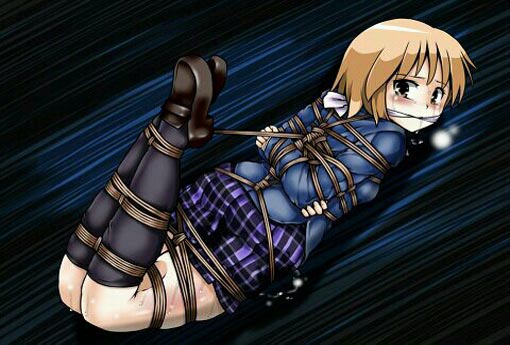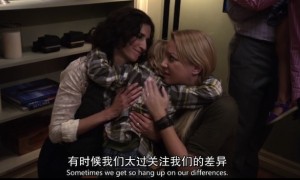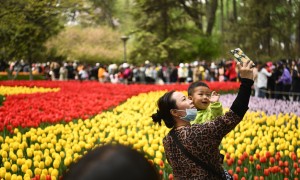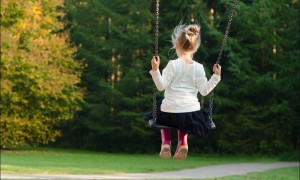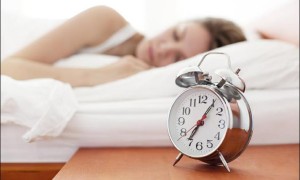Basic Information
Chinese name: rope art
Foreign name: rope art
Means: tight rope
Audience: Generally women
Type: one of SM
brief introduction
The art of rope binding originates from Japan, which literally means "binding" or "binding". It comes from the ancient Pengcheng Jiu-Jitsu art. It was originally used to bind prisoners in ancient times, but it has changed its form and has become an art of abuse. Combined with the rope binding skills passed down in ancient Japan, the model is bound and restrained without harming the model.
Types of rope art
back master
The classic upper body binding method. Easy to learn, no pain, moderate sense of restraint.
The steps for tying are as follows: Put the model's hands behind her back, support her elbows with both hands, and close her forearms. Wrap the rope about four times around the wrist, and tie the arm backwards. Don't wrap it too tightly. There is about a finger gap on the inside of the rope after tying. Continue to use the rope behind the back of the arm, pull up about an inch, then wrap the shoulder and upper arm laterally, and hang the rope on both hands. The height of the chest cord is just above the breast. Tie a knot at the back after wrapping multiple turns. Another rope is drawn from the large knot on the back, and continues to wrap around the shoulders and upper arms. The rope passes from the lower edge of the breast to the front chest, and is knotted at the back after twisting several times. The remaining rope is passed through the armpit and wrapped around the upper body rope Tight, so that the shape of the breast will be pulled out, but also to prevent the arm from sliding and breaking free. It is even more perfect to tighten the ropes above and below the breasts in front of the chest when binding formally.
This is the method that is emphasized in almost all elementary rope art textbooks, which is a typical binding. Because it conforms to the structural characteristics of the human body, the binding feels more comfortable, so the frequency of application is very high. Suitable for binding to all kinds of women. Moreover, there are many variants of joining slings and chest ropes on the basis of the rear master's little hand binding. It is a compulsory rope crafting skill.
Si horse bundle
With the most widely used binding method, all hands and feet are bound, and there is a strong sense of restraint.
Sima Binding is a method of full body restraint. The whole body has to be tightly bound, so it is very time-consuming, and it is more troublesome to tie up, and it also requires the patience of the model. Sima binding means that after tying the upper body and legs, the model's wrists and ankles are firmly tied together, and it is difficult to break free.
straight arm
A very wild method of tying the arms, the whole arm is shaped like a yah, which has a strong sense of restraint.
The rope is folded in half from the middle, wrapped around the neck, and the model's hands are placed behind the back in a "ya" shape. Then wrap and knot the rope around the model's chest around the elbows that are brought together. The model's palms should be facing each other. Then bind the wrists as well.
Tortoise Bound
Very beautiful full body binding method. The basic type is easy to learn, no pain, and moderate restraint.
The rope is folded in half from the middle, wrapped around the neck, and the sides hang down from the front of the chest. Tie a knot at the corresponding clavicle, the middle of the cleavage, the xiphoid process and the pubic bone in turn. Then it is strangled from the crotch, from the back up the spine, to the loop at the back of the neck, and knotted at a certain distance between them. After passing through the rope loop at the back of the neck, separate the two strands of the rope to the left and right, wrap it from the armpit to the front of the body, and pass through the rope loops in front of and behind the body in turn, from top to bottom, while arranging the position of each rope loop, Tighten the loop on one side. Finally, arrange the strands of the lower body so that they fall into the middle of the pubic area or separate them on both sides of the pubic area. Of course, you can also tie knots in the places corresponding to the genitals and anus, but this is beyond the scope of pure tortoise shell binding.
Tortoise shell binding is generally used as a body binding, not binding the limbs. Therefore, it is necessary to combine other methods to bind hands and feet. Because the pattern produced by the rope binding the whole body resembles the shape of a tortoise shell, it is called tortoise shell binding. If it is neatly tied, it can highlight the graceful figure of a woman, which is very beautiful. And any struggle of the model will first tighten into the pubic rope, which is a very sensual way of binding.
Rhythm rope
A simplified version of the tortoiseshell binding, mainly used as a non-binding binding. The diamond rope binding is a more advanced binding method. It is derived from the tortoise shell binding, and is divided into two types: chest rhombus rope and strand rhombus rope in specific applications. It is named after the rope net is rhombus-shaped after binding. As a non-restrained type of binding, diamond rope binding is very effective for shaping the model's body. The basic idea of the diamond rope binding is similar to that of the tortoise shell binding, and the appearance and tightness of the diamond rope are controlled according to the density of the rope knots in the middle. Various parts of the body can be used as objects for rhombus binding. Therefore, after mastering the skills of rhombus rope binding, almost infinite variants can be produced.
bondage
The method of whole body tight binding requires extensive experience and advanced skills. Create a complete sense of restraint.
There are many names for this binding method, such as peach binding, Hu sitting binding, Hai Lao binding, etc., all of which refer to this posture. Generally, the back hand is used to tie the upper body of the model first, and then help the model to cross the legs into a sitting position. Depending on the flexibility of the model, a lotus seat, a single plate or the most beautiful double plate is used. Tie it at the intersection of the two ankles, then draw out the rope to tie the thigh and calf of the left leg together, and tighten the remaining rope at the bend of the leg. Do the same binding for the right leg. Then draw out two strands of rope from where the hands are tied behind the back, go over the shoulders on both sides, tie a knot in front of the body and make one strand, and then tie it to the big knot at the ankle.
Stepping over the shoulders and connecting the ropes in front of and behind is very important in a group bond. By twisting the rope, the upper body and lower plate of the female partner can be continuously drawn closer, and finally tied tightly into a ball, like a peach, the model cannot make any physical movements at all during the whole tightening process. When the model was bound, it was painful because of the forced bending of the whole body and the stress on the back. Therefore, group tie is a famous method of tying for torture in history. In some group bindings, ropes are used between the model's braids and the cross-legged legs. In this way, even the neck cannot move freely, which is very painful. Women who like tight bonds can try it occasionally.
Do not tighten the rope all the time in the group binding, it can be loosened in time according to the model's physical strength and bearing conditions. If the model is not used to sitting cross-legged, her legs may be ischemia, sore and numb after being tied together for a long time, and she may even be unable to move for a long time after loosening. The characteristics of the bondage determine that the combination of bondage can quickly consume the model's physical strength. In addition, if the model who is bound by the group is pushed forward, it becomes a kneeling position with the upper body prone and cross-legged.
Reverse group bond
The whole body is bound, and the sense of restraint is strong and painful.
Rebellion is similar to China's four-horse tie-up, and it is also a form of binding during punishment or torture. The real reverse group binding requires the two wrists to be tied side by side behind the back, the two ankles side by side, and then in a prone position, the wrists and ankles are tied back together with ropes and fully hoisted. Because this binding method is very painful, the wrist and ankle are not strictly tied together when actually binding, leaving room for the flexibility of the model and the strength of the muscles. It is sufficient to lift off the deck with your knees and chest. The posture of reverse group binding makes the model completely lose the ability to resist and avoid the training of the chest. Reverse group binding puts a lot of pressure on the muscles and bones of the waist, so ordinary models cannot be bound for a long time.
back hands tied
How to tie your hands behind your head. Moderate difficulty, slight pain, moderate restraint. Different from "wrist binding", the steps of "hand binding behind the head" are: stretch the model's hands behind the head, bend the elbows upward, cross the wrists and tie them tightly. Then tie the forearm near the wrist and the upper arm with ropes so that the arm cannot be straightened. Finally, use the rope drawn from the intersection of the wrist and the binding, pull the wrist down from the back, and fix the arms behind the head. If only the hands are tied and the arms are pulled upwards, the head is tied with both hands.
The double-arm binding method behind the head is adopted, although it is more troublesome to tie up, and the model needs to cooperate patiently. The model's arms and hands are tied behind the head, which not only makes the chest more stretched, but also cannot cover the breasts, armpits, etc. at all. Therefore, tying the hands behind the head is one of the best poses to show the upper body of the model.
tied upright
Beginner full body binding method. No pain, moderate restraint.
The whole body is tied upright like a mat. Even if you are a novice, you can get a general idea by looking at the pictures. An upright bundle does not tie the joints, so the bundle is allowed to be very tight, which is suitable for long-term bundle placement. Pay attention to whether the rope loops all over the body are neat and beautiful, and the vertical and horizontal are clearly defined. If combined with the binding of both hands and wrists, the model can be hung neatly.
sling
Refers to the sling method in which the whole body is completely hoisted by the rope. Since the sling bears the entire body weight, it has a strong sense of restraint. Depending on the location of the binding, the level of pain varies.
There are also many ways to tie the whole body sling, such as: the whole body is tied vertically with both hands; the legs are tied upside down; the double leg is tied with the other leg after one leg is tied; the old sea is tied, the pig is tied , slings with separated limbs, etc. Since the rope bears all the body weight, the sense of restraint is very strong, and the technical requirements for binding are very high. In order to reduce the pain of the model, a large number of slings should be used to bear the weight of the body in scattered places, or a chair should be used as a support, etc., which can avoid the situation of poor blood flow of the model after binding. Regularly check the model's skin color and blood flow to avoid physical damage.
back hand tie
Intermediate hanging method, moderate restraint, moderate pain.
First, the model's hands are required to be together behind the back, and if the straight arms are to be tied, the model's hands are required to face outwards. Tie the wrist and upper arm with rope, and tighten the remaining rope in the middle. take another rope and wrap it around the elbows side by side, tighten the remaining rope in the middle, and then tighten it with the loops at the upper arm and wrist. Take another rope to tie the shoulders and upper body, and connect the remaining rope to the rope that ties the arms back to tighten. The model's arms can be lifted upside down by pulling the suspenders from the loops at the elbows and the upper body at the knots at the back.
The back hand is tied and hung, and the model's whole body weight must be borne by the upper body and the elbow loops. The cords of the forearm and wrist only serve as restraints.
one-legged
The single-footed hanging picture book is usually used as a continuous hanging method after the master and small hands are tied. The pain is less, and there is a strong sense of restraint.
After the body is tied with the hands of the back master, the sling is drawn from the large knot behind the back to hang the upper body, and the length of the sling is controlled so that the model just needs to lift both feet. Take another short rope and wrap the two ends around the middle of the thigh and the calf near the ankle, leaving about one meter long between the two loops as a tether. Pull the tether until the model’s single leg is completely lifted. The height of the chest is fixed, leaving only one leg of the model to barely stand on the ground.
The model with one leg hanging can just stand, but it is difficult to maintain its center of gravity, and there is a feeling that it will fall if it is not careful, so it is often necessary to adjust the center of gravity reluctantly.
hair tied
The method of tying the hair is not acceptable for models with short hair.
There are two main ways to tie the hair. You can braid the separate strands and rope together to form a hybrid braid, or you can braid the hair first and wrap the rope tightly in multiple loops. Both methods must have the most basic combing foundation, otherwise the tied hair will be loose. If the braids are not evenly stressed, and the hair is pulled when it is tightened, most models will be very disgusted. If you are not sure, you can ask the model to tie the hair into a braid with rope in advance, leaving the end of the rope.
Hair ties are generally used to control the model's head or line of sight. In the process of ordinary training, you can let the model watch or prevent the model from watching the process of being trained by tying the hair. When the whole body is lifted horizontally, the additional hair tie can reduce the stress on the cervical spine. However, it is absolutely impossible to use the braids as reins.
Guanyin
The binding method of the upper body and the hands is more complicated, and the flexibility of the model's arms is required to be good, otherwise it will not be easy to bind and uncomfortable.
The method of tying is generally similar to that of the back master and the small hands, but at the beginning, the palms of the hands are together behind the back, and the rope is first wrapped around one wrist and tied, and then led to the other wrist, and the wrists are tied together. The remaining rope was slightly twisted around the palms of both hands and the tiger's mouth, and tied the palms of the back together. Then raise a new rope to fix the left and right forearms and forearms in the proper position of the upper body.
The back-palm binding is an advanced rope binding technique. If the model is flexible, it will be very artistic after binding.
chest bondage
Refers to the method of binding the chest. Generally based on the binding of the upper body, there are no fixed steps.
The purpose of the chest binding is to help create the ideal shape. For example, the chest rope binding of the rear master and cleavage, which is a common chest binding method. Especially suitable for models with slightly less plump breasts. The bodice-like effect allows the breasts to rise naturally as the cords fit snugly on all four sides. For larger or slightly sagging, special chest binding methods can be adopted. For example, after completing the tortoise shell binding, use a string to make a cross-shaped binding on the top to help locate the chest. As for the binding of the root or the sling of the chest alone, since it is very likely to damage the tissue and cause irreparable damage, even if you try, you must pay attention to the reaction of the model and the congestion of the chest, and you must relax if you feel uncomfortable. In order to bring a strong masochistic experience and visual stimulation to the model. In addition, you can also make the model's hands clasped in front of the chest, keep the palms supporting the elbows, and the arms supporting the chest.
Crab binding
Crab binding is a binding method between peach binding and raccoon binding. Produces moderate restraint without pain.
The lower body of the crab tie is similar to the peach tie, the difference is that the feet are not crossed and tied, but the soles of the feet are tied behind each other, and the thighs and calves are also tied together and cannot be stretched. This posture with legs folded and flat resembles the shape of a crab. If the upper arms of both hands are tied to the inner side of the calf, the whole body is curled up, and the effect is even better.
ape bridle
The binding method of the head is moderately restrained and slightly painful.
Ape bridles generally have special restraints, including mouth plugs, mouth flails, mouth rings, nose hooks, eye masks, bridles, etc. Used to limit the sensory functions of the model's face, including vision and language. If a rope is used to realize the ape bridle, attention should be paid to the bearing capacity of the model, and it should not be tied too tightly, so as not to leave rope marks on the face. The gag will prevent the model from swallowing, and drooling will occur. The mouth gag completely limited the model's language ability and could only make a whimpering sound. Also, the gag can be removed at any time, while the cord cannot.
Su Qin carrying sword
A type of tied hands. Moderate restraint, slightly painful.
Tie the model's hands and wrists with ropes, and then connect one hand from the shoulders and the other from the side of the body to the back, and the hands are as close as possible to the back. According to the model's tolerance, the two ropes are connected and tightened. . In order to prevent the back of the arms from slipping, the upper arm and forearm are generally tied together with a rope near the elbow. Another rope is taken on the shoulders and armpits on both sides to make diamond-shaped limbs tied to fix the upper and lower wrists.
The binding process of Su Qin's back sword is simple, and the whole chest posture stretches after binding, and the effect of matching the chest rope is very good.
Equipment fixed
Binding of the body with aids. There is no pain, but there is a special sense of restraint.
Five Flowers tied
The so-called five flowers tied with five flowers means that five ropes run from a central point to five different directions. The traditional Chinese binding method is simple and beautiful, and there are many variants. It is the cultural accumulation of the Chinese nation for thousands of years and is called "national binding". I believe everyone has heard of it.
The so-called "five flowers" refers to the ¥-shape of the tied rope behind the back: ¥-shape is the 5 rope ends separated out, the top two rope ends are tied on the shoulders and wrapped around the front chest and cross tied or tied back along the armpit. The two rope ends in the middle bind the upper arm of the hand, and the bottom end hangs the wrist of the bound person. Another kind of understanding is ingenious: the word "flower" with five flowers means rope knot, which means five kinds of rope buckles. First of all, there is a double-loop "buckle" for threading the rope when it is put on the back of the neck. When the arm is wrapped around the wrist, there is a single-loop "buckle" at each of the two wrists, so there are three "pattern" buckles. (the buckles on the left and right wrists are actually the same).
Then, at the wrists of the reverse-cut hands, wrap the closed rope a few times and make a rope buckle. (This rope buckle is the key, it will be freed if it is not played properly), this buckle is often "looped" like a paper clip, because the rope will eventually pass through the rope buckle at the back of the neck and be pulled upwards. So it's safe to make a ring here. This is the fourth "flower". Finally, pass the end of the rope through the rope buckle reserved on the rope at the back of the neck, pull the rope down with one hand, and push up the hands tied behind the tied person with the other hand. Tie the knot at the place to complete the "five flower tie". At this time there are exactly five flowers (knots). Five flowers not only refer to the five flowers at the back, but also the front should be highlighted and tied! It is called the five flowers.


